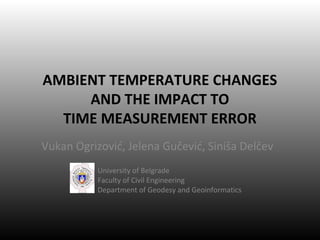Ambient Temperature Changes and the Impart to Time Measurement Error
•Download as PPS, PDF•
2 likes•394 views
National Conference of Astronomers of Serbia, Belgrade, 10-12 October 2011
Report
Share
Report
Share

Recommended
More Related Content
What's hot
What's hot (20)
A Numerical Study on the Iterative Techniques to Solve Partial Cavitation on ...

A Numerical Study on the Iterative Techniques to Solve Partial Cavitation on ...
Geotechnical Engineering-II [Lec #24: Coulomb EP Theory]![Geotechnical Engineering-II [Lec #24: Coulomb EP Theory]](data:image/gif;base64,R0lGODlhAQABAIAAAAAAAP///yH5BAEAAAAALAAAAAABAAEAAAIBRAA7)
![Geotechnical Engineering-II [Lec #24: Coulomb EP Theory]](data:image/gif;base64,R0lGODlhAQABAIAAAAAAAP///yH5BAEAAAAALAAAAAABAAEAAAIBRAA7)
Geotechnical Engineering-II [Lec #24: Coulomb EP Theory]
Applied Calculus: Physical Meanings/Applications of Derivatives

Applied Calculus: Physical Meanings/Applications of Derivatives
Similar to Ambient Temperature Changes and the Impart to Time Measurement Error
Lecture presented during the Climate Extremes WorkshopClimate Extremes Workshop - Extreme Values of Vertical Wind Speed in Doppler ...

Climate Extremes Workshop - Extreme Values of Vertical Wind Speed in Doppler ...The Statistical and Applied Mathematical Sciences Institute
Similar to Ambient Temperature Changes and the Impart to Time Measurement Error (20)
Asynchronous Differential Distributed Space-Time Coding

Asynchronous Differential Distributed Space-Time Coding
RF Module Design - [Chapter 1] From Basics to RF Transceivers![RF Module Design - [Chapter 1] From Basics to RF Transceivers](data:image/gif;base64,R0lGODlhAQABAIAAAAAAAP///yH5BAEAAAAALAAAAAABAAEAAAIBRAA7)
![RF Module Design - [Chapter 1] From Basics to RF Transceivers](data:image/gif;base64,R0lGODlhAQABAIAAAAAAAP///yH5BAEAAAAALAAAAAABAAEAAAIBRAA7)
RF Module Design - [Chapter 1] From Basics to RF Transceivers
Climate Extremes Workshop - Extreme Values of Vertical Wind Speed in Doppler ...

Climate Extremes Workshop - Extreme Values of Vertical Wind Speed in Doppler ...
Phase-field modeling of crystal nucleation II: Comparison with simulations an...

Phase-field modeling of crystal nucleation II: Comparison with simulations an...
Phase-field modeling of crystal nucleation II: Comparison with simulations an...

Phase-field modeling of crystal nucleation II: Comparison with simulations an...
Formations Near The Libration Points: Design Strategies Using Natural And Non...

Formations Near The Libration Points: Design Strategies Using Natural And Non...
Development of a Pseudo-Spectral 3D Navier Stokes Solver for Wind Turbine App...

Development of a Pseudo-Spectral 3D Navier Stokes Solver for Wind Turbine App...
2007 EuRad Conference: Speech on Rough Layers (odp)

2007 EuRad Conference: Speech on Rough Layers (odp)
Computational Information Geometry on Matrix Manifolds (ICTP 2013)

Computational Information Geometry on Matrix Manifolds (ICTP 2013)
2007 EuRad Conference: Speech on Rough Layers (ppt)

2007 EuRad Conference: Speech on Rough Layers (ppt)
Development of Methodology for Determining Earth Work Volume Using Combined S...

Development of Methodology for Determining Earth Work Volume Using Combined S...
Ambient Temperature Changes and the Impart to Time Measurement Error
- 1. AMBIENT TEMPERATURE CHANGES AND THE IMPACT TO TIME MEASUREMENT ERROR Vukan Ogrizović, Jelena Gučević, Siniša Delčev University of Belgrade Faculty of Civil Engineering Department of Geodesy and Geoinformatics
- 2. Vertical deflections Natural coordinates (Φ,Λ) Elipsoidal coordinates (φ,λ) - astronomical - - geodetic - Φ 5 = const. φ5 = const. Φ 4 = const. φ4 = const. Φ 3 = const. φ3 = const. Φ s = const. φs = const. ξ = Φ − φ = const. φ Φ1 = const. 1 η = ( Λ − λ ) cos φ A − α = ( Λ − λ ) sin φ
- 3. Measuring systems for (Φ,Λ) determination TZK2 - D DIADEM (Institut für Erdmessung, (Eidgenössishe Technische Hannover) Hochschule, Zürich)
- 4. Time-keeping in field • 1PPS from GPS to DB9 via RS232 • GPST to quartz oscillator ticks • RTOS
- 5. Frequency vs temperature plots • Variations in temperature -> major influence on the crystal frequency • Changing the curvature of a crystal cut can make the slope less steep
- 6. Experiment set-up • Time reference: Trimble NetRS w Zephyr Geodetic • UTC source: 1PPS output (BNC type) wired to DB9 • SI second acquisition: Interrupt handler under RTOS • Resolution: 133 MHz ≈ 7 ⋅10 −9 s
- 7. Set-up #1 - Testing performed outdoors - Ambient temperature: ~17°C - Measuring session: ~2 h Raw data After removing the blunders
- 8. Set-up #2 - Testing at different environmental conditions - Ambient temperature increased from 0°C to 21°C - Measuring session: ~5 h Raw data After removing the blunders Set-up 2a Set-up 2c Set-up 2b
- 9. Calculation of the clock model • Four tests, each cca 2 h long: – #1: T = 17°C – #2a: T = 0°C – #2b: T = 21°C – #2c: 0°C < T < 21°C • Clock drift & bias according to the linear model: UTCi = T0 + (1 + h )Ti
- 10. Calculated biases (tab'd) Set-up # T [ °C] h [s/h] sh [s/h] 1 16 0,003 0,001 2a 0 -0,033 0,002 2b 20 0,006 0,002 2c 0-21 -0,026 0,003
- 12. Conclusion and remarks • Clock bias strogly dependent on temperature • Need for stable environmental conditions • Shorter session -> linear clock model
- 13. Thank you for your attention! University of Belgrade Faculty of Civil Engineering Department of Geodesy and Geoinformatics Vukan Ogrizović, vukan@grf.bg.ac.rs Jelena Gučević, jgucevic@grf.bg.ac.rs Siniša Delčev, delcev@grf.bg.ac.rs